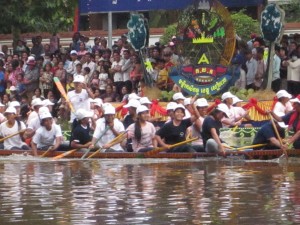Modified from the original post on November 23, 2010 on Girl Meets World, which chronicled my travels in Vietnam and South East Asia.
“Hundreds Die in Cambodian Stampede” is the current headline on the BBC Asia-Pacific News homepage. The accident occurred in Phnom Phen, while I celebrated the festival in Siem Reap–I had been in the country’s capital days before and was taken aback by the news. After a concert following the races of the Water Festival, hundreds crammed a bridge and sudden pushing caused a panic that started a crush that has killed over 300, injuring many more.
Bon Om Tuk, the Water Festival, held in Cambodia this weekend, features long, narrow dragon boats racing furiously downriver while crowds jam the riverside. Thousands come from the countryside to see the festivities either in Phnom Phen or Siem Reap. I was lucky enough to be part of the festivities Saturday in Siem Reap, while visiting the city to tour the legendary temples of Angkor Wat.
 While on a Skype call, catching up with my parents after returning from Cambodia to HCMC, my dad told me the count was up to 300. I had to excuse myself from the conversation while overwhelmed with emotion. The festivities I saw in Siem Reap were such a uniquely Cambodian experience. Everything in Siem Reap revolves around tourism since the legendary temples of Angkor Wat lie less than 10 miles away from the city center. But this was a celebration of Cambodia, for Cambodia.
While on a Skype call, catching up with my parents after returning from Cambodia to HCMC, my dad told me the count was up to 300. I had to excuse myself from the conversation while overwhelmed with emotion. The festivities I saw in Siem Reap were such a uniquely Cambodian experience. Everything in Siem Reap revolves around tourism since the legendary temples of Angkor Wat lie less than 10 miles away from the city center. But this was a celebration of Cambodia, for Cambodia.
The Tonlé Sap is the largest freshwater lake in South East Asia, a crucial life force, providing nearly half of the country with fish and water for irrigation. The Water Festival marks the time when the Tonlé Sap reverses its flow of water, pouring its resources back into the Mekong Delta after the flooding of the monsoon season. In other words, not only is it a big deal for area ecosystems, but the festival is also a big part of Cambodian culture.
Everybody came out for the party—teens dressed to impress in fashionable jeans and hoodies, vendors selling everything from food to iPod cases, children holding animal-shaped balloons, old women and men wrapped in traditional skirts. Carts filled with street food from every kind of meat-type-item-on-a-stick to freshly cut fruit to ice cream to paper-thin banana chocolate “pancakes” filled with sweetened condensed milk. Carnival rides and bouncy houses provided family-friendly entertainment and everybody shared the grassy banks of the river to watch the races. Fireworks ended the night. It was refreshing to see something not catered to foreign tourists, and the night really represented Cambodia coming to find out who she is on her own.
A friend who works ESL in Siem Reap was going to go to Phnon Phen for the festival, but decided to go to the beach hub of Sihanoukville instead. She warned us about the crowds expected in both locations, and I considered myself lucky to be in Siem Reap where the festivities would be lively, but certainly not as crowded as the capital.
This eyewitness account from the BBC of Australian Sean Ngu, who was visiting friends and family in Phnom Phen, recalls the events from the festival.
“The water festival is one of the most important celebrations in the year and many people arrive from the countryside. The city is full of people. It is very quiet right now, apart from the ambulances. What a tragic end to a wonderful celebration.”
Despite crippling poverty, government corruption, and years of war-plagued misery, Cambodia has promise of recovery. The tourist industry has helped put the country on the map for something other than poverty, and Cambodia is emerging as a major stop on the South East Asian loop. I honestly loved Cambodia, from what I could gain from my weeklong stay.